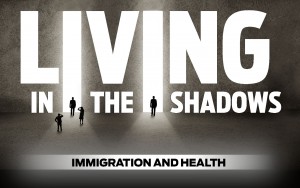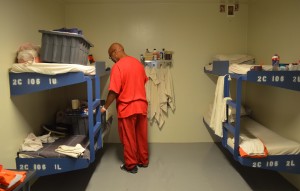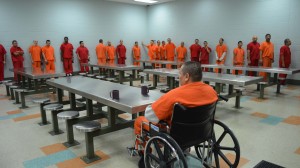By Alonso Yáñez, Reporting on Health Collaborative

One of the detainees at Adelanto leans against the door of a holding cell. Photo: Alonso Yáñez /La Opinión.
Juana Lopez squeezed her son’s hands and caressed his forehead.
“I’m here, mi’jo,” she said. “Your mom’s here. React. Try your best.”
That was the first time Lopez had seen her son in more than three months. That day, with her son unconscious and breathing with an artificial respirator inserted in him, was also the last day she saw Fernando alive.
Fernando Dominguez Valdivia, a 58-year-old Los Angeles resident, died March 4, 2012, eight days after his mother visited him at Victor Valley Community Hospital. He had developed bronchopneumonia during the 100 days that he was under the custody of U.S. Immigration and Customs Enforcement (ICE).
“It was negligence. It was lack of medical attention,” Lopez said. “If that happened to my son, it’s going to continue to happen to everybody who ends up there, that they don’t give them the treatment they should.”
Dominguez Valdivia was detained two months and a half at the Adelanto Immigration Center, a detention complex for men built in the Mojave Desert, about 90 miles northeast of Los Angeles. It was constructed in 1991 and used for several years to house convicts until the GEO Group, an international detention center private corporation, bought it in 2010. In May 2011 a contract was signed with ICE to house immigrants in two wings, east and west.
Adelanto has new infrastructure in its west wing, but detainees in Adelanto told Univision that the east wing had leaking, broken pipes. That’s where Valdivia stayed while he fought bronchopneumonia without receiving adequate medical attention. Once in the hospital, the infection spread to the bloodstream, which eventually resulted in multi-organ failure.
The U.S. Office of Detention Oversight found that Dominguez Valdivia’s death could have been prevented and that the center did not comply with the detention guidelines set by ICE.
Although Dominguez Valdivia’s death is the only one that has occurred in Adelanto, there have been more than 130 other deaths since 2003 in the 250 detention centers for immigrants in the country. The causes of death range from asphyxia to cardiopulmonary arrest and drowning. More than 400,000 people pass through the national network of detention centers every year.
ICE owns eight detention centers. It also contracts out detention with private companies, such as the GEO Group, Corrections Corporation of America or Management & Training Corporation and with state and county governments. The population of detained immigrants is equally distributed with about half in private detention centers and half in public centers.
Catalina Nieto, field director at the immigrant advocacy organization Detention Watch Network, said that both private and public detention centers contend with the same issues: waits of weeks or even months to receive medical attention, bad quality and inadequate food and water, very few hours with access to sunlight or fresh air and too much of a distance between these centers and urban areas. That can make it hard for the detainees to maintain contact with their families and have access to quality medical care.
According to a national investigation published by Detention Watch Network, at the end of 2013, none of the 250 detention centers can guarantee the detainees basic medical care, adequate protection against physical and sexual abuse and enough contact with the outside to preserve their families and adequately prepare their legal defense. Two of the main problems in the system, Nieto said, are the lack of independent oversight and the fact that detention centers do not apply the same standards because of contractual reasons.
Immigrants in ICE custody are technically under civil detention, which does not necessarily mean that they committed a crime, but that they are being detained until a judge decides their case. That detention mandate for the undocumented occurred because of the enactment of the Illegal Immigration Reform and Immigrant Responsibility Act in 1996, which also broadened the definition of aggravated felonies, allowing for minor crimes under criminal justice to be considered a felony under the immigration legal framework.
Watch the first part of our report.
War on terror puts immigrants in lock up
In 1995, there were 6,785 immigrants detained in detention centers nationwide. Over the next two decades, the number exploded, more than quadrupling to 34,000 as of 2013.
The boom of the detention network has its roots in the two biggest tragedies caused by terrorism on United States soil. Two federal laws were enacted as a response to the domestic terrorist attack by Timothy McVeigh to a federal building in Oklahoma City on April 19, 1995. The attack came two years after a bombing attack on the World Trade Center in New York by a group of men from Kuwait, Jordan, and Pakistan. Although McVeigh was American, the attack created a climate of fear and uncertainty in America. The new federal laws, among other things, created program 287g, which authorized local police to enforce immigration laws, and expanded mandatory detention.
“Approximately 70% of people are detained today because of the mandatory detention,” Nieto said.
Then the September 11, 2001, terrorist attacks happened. That led to a wave of anti-immigrant sentiment in the country, and it also moved the immigration system under the control and responsibility of the Department of Homeland Security.
In 2005, Congress instituted what has become known as the “bed mandate”, which requires ICE to have 34,000 immigrants every day. Janet Napolitano, former secretary of DHS, told a House committee that the mandate was artificial and prevented ICE from being as effective as it could be, but Congress has continued to raise the mandate, hitting 34,000 in 2011. A 2010 report by the Immigration Policy Center concluded that 10% of people deported are legal immigrants and that the majority of them (68%) committed minor non-violent crimes.
Circumstances seemed to change when President Barack Obama took office for his second term, bolstered by the Latino vote. It is now official federal policy for DHS officials to focus on deporting criminals, repeat immigration offenders and recent border crossers. Homeland Security officials report that 98 percent of deportees in fiscal 2013 fell in those groups.
But immigration advocates challenge the official numbers, saying the mandate to fill 34,000 detention beds puts pressure on Homeland Security officials to cast a wider net – especially at a time when new border crossings are falling. Of the roughly 400,000 people detained during 2013, 151,835 did not have a criminal conviction other than a traffic violation, according to ICE. The annual cost to detain immigrants, regardless of their criminal record, totals more than $2 billion, according to a report by the National Immigration Forum.

This is the food that was served at Adelanto when KMEX visited. Two slices of bread, raw onions, some salad, beans and an orange. Photo: Alonso Yáñez/La Opinión.
According to a decision by the Supreme Court in 2001, immigrants have to be deported or freed in six months. However, many languish behind bars for more than a year, according to federal agents and immigration attorneys.
“In a normal situation, where they come in and see the judge, the average is 45 to 60 days (in detention),” said Roberto Naranjo, assistant field office director for ICE. “But that’s relative because there are many individuals who choose to fight their case and decide to appeal, and stay in the detention center until that decision is made. So it could be six months to a year and a half. But it depends until what point the individual detained wants to stop the appeal.”
Today, in spite of the sharp decrease in illegal immigration to the U.S., the fiscal deficit and the relaxation of immigration criteria for deportation, the U.S. has the biggest immigrant detention infrastructure in the world and there are plans to extend it more. Gradually, that enormous network for immigrants has become a bigger fraction of the even-bigger American prison system, which houses about 2.3 million people.
Watch the second part of our report.
As immigrant detention centers have expanded, so has the private detention industry. The first private detention center for immigrants was opened by CCA in 1984 in Houston, and it wasn’t until after the 9/11 attacks that private prisons really took off.
Private detention centers on the rise

A guard walks a detainee through one of the the hallways in the west wing in Adelanto. Photo: Alonso Yáñez/La Opinión.
From 2002 to 2010 there was a 206% increase of ICE detainees in private centers, according to the agency. Profits and lobbying expenditures went up, too.
Both CCA and GEO had earnings of more than $1,200 million in 2010 and their CEO’s, Damon Hininger and George Zoley, respectively, made more than $3.4 million each that same year. CCA alone has spent more than $19 million alone on lobbying through 2013, according to the Sunlight Foundation.
The private sector has reaped many rewards from the expansion of the immigrant detention system. But the system’s growth has also given rise to concerning cases of abuse and neglect, complaints, criticism, lawsuits and dozens of deaths.
Carmen Iguina, an attorney with the ACLU of Southern California, says she frequently hears complaints about delays of weeks and even months for a detainee to see a doctor. When asked about this issue, ICE’s Naranjo said that detainees are seen within 24 to 48 hours after they make a request. However, detainees and advocates for immigrant rights said that the delays are habitual.
“It’s not that they are not competent, but that there aren’t enough medical resources,” said Iguina. “And many times the decisions are taken based on saving money and not the medical need.”
For Cristina Fialho — lawyer and co-founder of Community Initiatives for Visiting Immigrants in Confinement, a national coalition that makes more than 15,000 visits to detention centers annually — the growing influence of private corporations in the immigrant detention network creates an additional hurdle for oversight. Private detention companies are not subject to laws that promote transparency, such as the Freedom of Information Act, which require federal agencies to release files on investigations of misconduct or improper care as well as memos on internal decisions.
“I think it goes back to our ideals as Americans,” Fialho said. “If we are a country that prides itself on liberty, on basic fairness, on due process, but we’re not providing the most vulnerable people in our society with that level of fairness, of freedom, of medical care, then what kind of country are we? Are we not living up to our ideals as the United States?”
Although standards for immigrant detention have been updated to provide better conditions and services, today the 250 centers in the US operate under three different versions of ICE guidelines. The reason for that discrepancy is the contractual agreements signed over the years with different counties and states, some of which are binding to old standards and even renew automatically with those provisions. While the 2000 and 2008 guidelines, Fialho explained, only guarantee medical attention in case of emergencies, the 2011 version ensures medical services for “serious conditions.”
“The idea of what a serious medical condition is really up to interpretation,” said Fialho.

A few detainees work out at Adelanto. Ther facility holds about 1,300 people. Photo: Alonso Yáñez/La Opinión.
Although the complications that Fernando Dominguez Valdivia had in Adelanto before he died in 2012 were, for example, so serious that they resulted in his death, he was given medication and denied more medical attention until it was too late, according to his family.
According to a detainee from Adelanto with HIV, who asked to keep his identity anonymous for his safety, the attention provided at the center isn’t proper. He said his requests to see a doctor were ignored and that he doesn’t get psychological assistance. Ariel Alejandro Zeledón, a detainee with bipolar disorder, said that he sees a psychiatrist once a month and never gets to see a psychologist for counseling.
“They only want to know if you need medication,” said Zeledón.
When asked about these allegations, ICE responded both detainees have received comprehensive medical care since coming into their custody. Medical records indicate that the detainee with HIV had more than 25 appointments with healthcare personal in 2013 and also that mental professionals have been working closely with Zeledon to address concerns the detainee has about the dosages of his psychiatric medications.
The ripple effect of detention
The cost to house an immigrant fluctuates between $122 and $164 daily, according to ICE.
Among some of the alternatives to detention that immigrant rights advocates propose are electronic monitoring bracelets, phone check-ups, or in-person visits. These options to massive incarceration would cost much less than the current practice and range in cost from 70 cents to $17 per day, according to a 2013 report by the Center for Victims of Torture.

A family about to enter the Adelanto facility, possibly to visit a detainee. Photo: Alonso Yáñez/La Opinión.
The shift to fewer people in detention also would lessen the impact on families, including families with U.S.-born children, said Hiro Yoshikawa, professor of globalization and education at the University of New York, Steinhardt, and author of the book “Immigrants raising citizens: Undocumented parents and their children.”
“I’d say the economic impact is immediate. When a parent is detained or deported, the household loses that parent’s income and that can mean the entire income of a household or an enormous proportion, so that can immediately create economic hardships,” Yoshikawa said. “Also it creates immediate psychological stress and trauma, which can affect all the remaining adult and children in the family.”
In August 2009, ICE launched reform within the detention system, aiming to improve conditions and health services. Two of the most important steps to improve the detention system were the medical and mental screenings detainees get within 12 hours of admission and better translation and language access for detainees with limited English proficiency.
According to Virginia Kice, Western Region Communications Director for ICE, these reforms ultimately will address the majority of complains about the system. Other significant accomplishments of the reform include simplifying the process for detainees to receive authorized health care treatments and developing a medical classification system to support detainees with unique medical or mental health needs.

Wesley Lee and Roberto Naranjo talk with reporter Annabelle Sedano in a hallway of the west wing. Photo: Alonso Yáñez/La Opinión.
Roberto Naranjo, assistant field office director for ICE, said that there were two doctors, two psychiatrists and two psychologists working eight hours a day, five days a week at the Adelanto detention complex near Los Angeles. In case of emergencies, all detention centers have arrangements with nearby hospitals.
Fialho said that the changes in immigrant detention standards would have more impact if detention centers provided preventative care and other health care services and not just treatment for “serious conditions,” as required by law currently.
“If people in immigration detention were provided with more basic medical care, so that they were provided with regular check-ups, with better mental health, we wouldn’t see the deaths we’ve seen,” Fialho said. “We wouldn’t see the suicides that we’ve seen and we wouldn’t see the emergencies that we’ve seen, which actually cost a lot more money than just providing the basic level of medical care in the first place.”
Watch the final part of our report.
Annabelle Sedano contributed to this report.
 About Living in the Shadows: This project results from the Reporting On Health Collaborative, which involves MundoHispánico in Atlanta, New America Media in California and New York, Radio Bilingüe in Oakland, WESA Pittsburgh (an NPR affiliate), Univision Los Angeles (KMEX 34); Univision Arizona (KTVW 33), and ReportingonHealth.org. The Collaborative is an initiative of The California Endowment Health Journalism Fellowships at the University of Southern California’s Annenberg School for Communication and Journalism.
About Living in the Shadows: This project results from the Reporting On Health Collaborative, which involves MundoHispánico in Atlanta, New America Media in California and New York, Radio Bilingüe in Oakland, WESA Pittsburgh (an NPR affiliate), Univision Los Angeles (KMEX 34); Univision Arizona (KTVW 33), and ReportingonHealth.org. The Collaborative is an initiative of The California Endowment Health Journalism Fellowships at the University of Southern California’s Annenberg School for Communication and Journalism.
We Want to Hear from You! As the Living in the Shadows series unfolds, we welcome your ideas. You are part of the story too and we invite you to share your perspective and experiences by writing to immigranthealth@reportingonhealth.org, calling us at (213) 640-7534 or by joining the conversations on these topics on Facebook at https://www.facebook.com/immigrantshealth or on Twitter at @immighealth.















